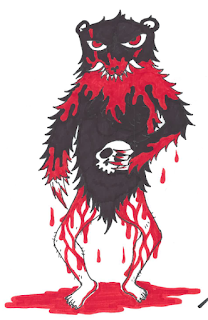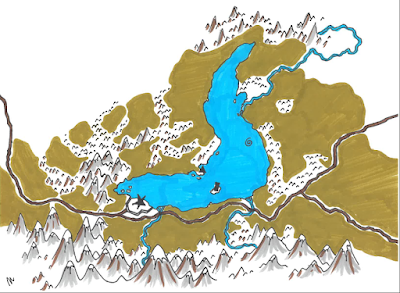In the year 1837, a short paper was read by me before the Geological Society of London, “On the Formation of Mould,” in which it was shown that small fragments of burnt marl, cinders, &c., which had been thickly strewed over the surface of several meadows, were found after a few years lying at the depth of some inches beneath the turf, but still forming a layer. This apparent sinking of superficial bodies is due, as was first suggested to me by Mr. Wedgwood of Maer Hall in Staffordshire, to the large quantity of fine earth continually brought up to the surface by worms in the form of castings. These castings are sooner or later spread out and cover up any object left on the surface. I was thus led to conclude that all the vegetable mould over the whole country has passed many times through, and will again pass many times through, the intestinal canals of worms. Hence the term “animal mould” would be in some respects more appropriate than that commonly used of “vegetable mould.”
-Charles Darwin, The Formation of Vegetable Mould through the Action of Worms, 1881
The world of the jinn is like a translucent layer atop mortal reality, where those made of smokeless fire and other spirits are always unhidden. But, if one with eyes unclouded were to peer into this layer, in addition to the monstrous forms of shimmering spirits, they would see something else: a thin and somewhat mushy layer of what looks like softly glowing dirt. A field of this substance, spirit dirt or memory mold, blankets the world of the jinn, a thin layer even abounding on human architecture and statuary, and on the shoulders of those who bathe (either with water or sand) very infrequently. This humus (not hummus!!) is the product of one of the perhaps most humble subjects of the realm of spirits, the mnemovore worm.
Mnemovore Worm
Number Encountered: 2d4 OR 1 swarm
Hit Dice: 1 hit point OR 1+1 HD for a swarm
Attacks: 1 mental bore OR 6 mental bores (when in a swarm) (see below)
Attacks: 1 mental bore OR 6 mental bores (when in a swarm) (see below)
Armor: none
Morale: 4
Mental Bore: Mnemovore worms leap up from the spirit dirt and pass straight through their victim's skull in search of their quarry: memories. The target must save vs. wands or forget something, determined at random:
Roll 1d12:
- A memory from their youth.
- An event from a month previous.
- An event from a week previous.
- An event from the day previous.
- An NPC the party has worked with (this can include hirelings).
- How to exit the dungeon or how to find their way back home.
- How to use one of their weapons (disadvantage on to-hit rolls, removed after familiarity returns 1d6 attacks with the weapon later).
- Ability with a skill or power other than spellcasting (disadvantage on rolls with said skill, removed after familiarity returns 1d10 attempts later).
- 1 prepared spell (they don't forget the spell completely, they just no longer have it prepared that day; if a non-spellcaster, re-roll).
- Knowledge of 1 spell entirely (would have to seek out a teacher to re-learn the spell; if a non-spellcaster, re-roll).
- Ability with a language (bumped down from fluency (if they could write the language, they lose that completely); if rolled a second time (3rd if they could read and write), they no longer speak that language).
- An aspect of their personality (re-roll INT, WIS, or CHA, determined at random).
Psychic Attraction: Mnemovore worms are attracted to magic-users, especially higher-level magic-users, as well as charismatic leaders. If a character has 15+ CHA or 3+ spells memorized, roll 1 die size higher on the wandering monster table (so d8 instead of d6, etc.); any results above 6 will be encounters with mnemovore worms. If a character has 6+ spells memorized, roll 2 die sizes higher (so d10 instead of d6, etc.).
Spirit: As spirits, mnemovore worms are immune to damage from mundane weapons. They take damage from magic, heated up silver weapons, intelligent swords, and the attacks of jinn. They can pass through clothing, armor, and flesh as if it wasn't even there, but cannot pass through walls. They can only be seen by jinn or by those with eyes unclouded.
Mnemovore worms are a crucial part of the spiritual-magical-mental ecosystem. They are the primary cause for forgetfulness, saving human brains from being overloaded with too much information. And, though humble and small, these little worms are one of the things keeping wizards in check. There are more than a few stories of sorcerer-tyrants from ages past steaming themselves to death in specially constructed silver contraptions heated with boiling water in order to keep the mnemovores out.
Memories enter a mnemovore worm through the mouth, and exit as spirit dirt. This memory-based mass serves as the fertile ground for all sorts of phantasmal plants which populate the realm of the jinn. While jinn generally (hehe, jinnerally) eat the same grains and meats that humans do (albeit generally restricted only to what is left over uneaten by humankind), they supplement their diets with such spectral produce. Phantasmal plants are also used by the jinn as medicine, and a gift of ghost-root or invisible leaf (or even the intel to know where a copse of such plants grows) is a reward a jinn may give to an ally, friend, or master.
 |
| A selection of phantasmal plants from below: a fishroot, a crawling scaletree, some grasping fragrances, some thief's eyes, and a wilting faint |
1d12 Phantasmal Plants
- Crawling Scaletree: A race of ancient antediluvian tree with bark like reptile's scales and thin needles on its branches. Ever since going extinct their ghostly forms crawl across the spirit-dirt aimlessly.
- Fishroot: From the surface of the memory mold, appears as a mass of long pale fronds, but when uprooted, its wriggling eyeless fish form is revealed. The fronds can be eaten to cure stomach ailments, despite its astringent bitter taste. The fish-like root has a fatty liver that can be rubbed on weapons to make them temporarily phase between worlds.
- Ghost Ginkgo: Strangely enough, ginkgo trees span the divide between worlds. Their foul-smelling fruits have no uses, but their seeds and leaves can cure lung and kidney illness. These eastern trees are only known over here in the menageries of sorcerers and nobles.
- Ghostgrass: Tall stretches of softly glowing pale green grass, gently swaying in the nonexistent breeze. Causes mysterious feelings of cold when passed through, whether one can see the grass or not.
- Grasping Fragrance: Sprouting directly out of the spirit dirt, grasping fragrances reach for those who pass, hoping to attach onto them and spread their fragrance (the means by which they reproduce) far and wide. Smelling the wrist of a grasping fragrance cures paralysis.
- Hedgehog Herb: Only visible in the realm of men and beasts during the full moon, and very few even know what it looks like then. When its leaves are rubbed on metal locks, it corrodes them.
- Pillarwife: About five-foot tall pale trunks that ooze a salty sap when cut. Very confused deer and goats gather around the sites of phantasmal pillarwives without being able to find where the salt lick actually is.
- Prickly Marid: A rebellious plant that does anything it can to not be cut, squirming out of the way of blades. Its stalks can be brewed into a tea: drinking it causes blindness, while pouring it on petrified flesh un-petrifies it (and the reverse for un-petrified flesh).
- Sprouting Id: A thorny bush with a single bright red flower at its apex. When picked and made into a tea, it brings out the worst, most base aspect in the drinker.
- Thief's Eyes: A plant that spans the jinn's world and the world of men and beasts, with eyes clouded it appears as thin stalks tipped by eye-shaped berries, while in the spirit world these eyes are surrounded by ghostly ghoulish faces. When eaten causes hidden gold to glow in one's vision for 1 hour.
- Vengeful Father: A sprouting bush that superficially looks like a laid-out dead body. It produces juicy brightly-colored fruit, sweet-smelling and sweet-tasting, that (when the skin is broken) painfully lash out with knife-sharp edges of its inside flesh.
- Wilting Faint: Its petals form a vaguely humanoid outline, one arm held across the "forehead" as if fainting. If eaten, induces fainting, but its scent breaks fevers.
-------------
It took everything in my power to not call them ectoplasmic worms a la Noroi or Senritsu Kaiki File Kowasugi (check those out if you're at all interested in Japanese horror films, Koji Shiraishi is the GOAT). While the above is written with King of Kings in mind, I intend on incorporating the mnemovore worms into other game settings, namely Gamma Ohio or modern horror like the short mini-campaign using Underneath that I made one post about a couple years back. I really gotta get around to cleaning up my notes from that campaign and putting them up here, modern horror TTRPGs is something I'd like to do more with! Anywho, keep your heated silver ready if you've got a lot of thoughts bangin' around up there, and see you next time!









